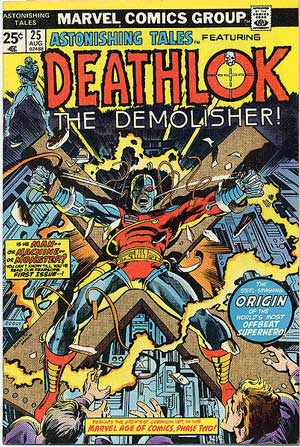 Deathlok the Demolisher - Of the many wonderful characters created during the Bronze Age, I'd have to say my favorite is Deathlok. (I know - this may come as a shock to those of you familiar with my devotion to Woodgod.) I think the reason is because Deathlok, more than any other character, is a mixture of the various elements that typify the Bronze Age.
Deathlok the Demolisher - Of the many wonderful characters created during the Bronze Age, I'd have to say my favorite is Deathlok. (I know - this may come as a shock to those of you familiar with my devotion to Woodgod.) I think the reason is because Deathlok, more than any other character, is a mixture of the various elements that typify the Bronze Age.
In 1974 Artist Rich Buckler, who had worked at both DC and Marvel quite a bit and was ready to create his own character. His choice was a Colonel Luther Manning a soldier who dies in a war in 1983 only to wake up in the terrifying future of 1990 to discover he has been turned into Deathlok, a cyborg assassin by the evil Harlan Ryker as part of conspiratorial project called Alpha Mech.
While his face is decayed and disfigured (from years of being dead no doubt) his arms and legs have been replaced with cybernetics, making him the Army’s first bionic soldier. He has also been gifted with an almost omniscient AI in his head which he commonly refers to as 'Puter. Deathlok was originally going to be called Dedlock until five minutes before Rich’s pitch meeting with Roy Thomas, Doug Monech convinced Rich to use Death instead of Ded because he (rightly) thought it sounded better.
In the first issue, Deathlok frees himself from the Army’s control and to fight Ryker. For 12 issues of Astonishing Tales Deathlok fights against Ryker’s army and other futuristic foes until issue 36 where Manning's mind is restored into a clone of his original body and the cyborg body of Deathlok is sent spiraling into a Time Portal by a foe called Godwulf.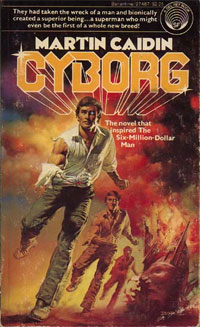 A note here - I used the term cyborg to explain his appearance, and I think this makes good place to examine the popularization of the term. In 1972, Martin Caiden wrote a novel called Cyborg. In 1973 Cyborg had been adapted into a top-rated TV movie. In 1974 Universal studios licensed Caiden’s novel to create the 6 Million Dollar Man as a regular series on ABC. At this point, Cyborgs were all the rage, so it should be no surprise that someone would eventually base a comic character on the idea.
A note here - I used the term cyborg to explain his appearance, and I think this makes good place to examine the popularization of the term. In 1972, Martin Caiden wrote a novel called Cyborg. In 1973 Cyborg had been adapted into a top-rated TV movie. In 1974 Universal studios licensed Caiden’s novel to create the 6 Million Dollar Man as a regular series on ABC. At this point, Cyborgs were all the rage, so it should be no surprise that someone would eventually base a comic character on the idea.
Interestingly enough, the 6 MDM almost killed Deathlok as a concept at Marvel. At the same time that Buckler was developing Deathlok, Marvel was thinking about licensing the 6 MDM for a comic book. This license would eventually go to Charlton. When this happened, Roy Thomas gave Buckler 12 issues of Astonishing Tales to use as a vehicle to introduce Deathlok to the world.
Outside of his 12 issue run in Astonishing Tales, Deathlok made a few random appearances in other Marvel series (Marvel Two In One, Marvel Team-Up) His last appearance in this incarnation was Captain America 286-288 in an J.M DeMatteis penned arc called Deathlok Lives.
As a concept, Deathlok was reintroduced in the 90's under the skillful guidance of Dwayne McDuffie. This version of the character was visually similar to the Bronze Age version, but what had been removed was the dystopian mise en scene. And while this version ran in his own comic for longer than his bronze age counterpart, I don't know that he was more well liked by the fans. This was an era when Darkhawk ran for 50 issues, remember? ;)
I think the main problem with revamping Deathlok in the 90's is that so much of his intrinsic appeal lies in those characteristics and themes which dominated the 70's bronze age. When transplanted into the 90's much of the zeitgeist that gave birth to the character was largely gone.
For instance, during the Bronze Age, we saw Monsters become lead characters with such titles as Dracula, Werewolf by Night, Man-Thing, The Beast etc. Because they looked so different from the usual lantern jawed superheroes, monsters as heroes definitely had a much greater *cool* factor about them, and Deathlok's horrifying appearance definitely put in him in this same category. This was an artistic decision made by Buckler who said he did this on purpose. In TwoMorrow’s BackIssue 25, Buckler explains it like this…
…I deal in reconciling opposites – So while the 6 Million Dollar Man was a good looking guy, I took that all away from Deathlok. I made him a monster, and instead of being friends with technology, he was enemies with it…
I think Buckler succeeded in this goal by contrasting Deathlok's grotesque features with his sleek and shiny legs and arms and utilitarian costume/uniform. While the colorful costumes of Nova or Iron Fist looked like they could come off the rack at the Marvel Mall, Deathlok's costume had a lean design that was practically Soviet Issue. A very important artistic purpose was served with his costume as without leggings or sleeves, his uniform helped draw attention to his metallic limbs.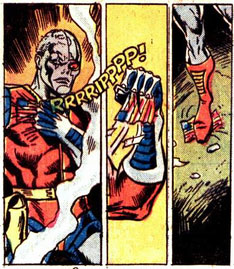 A small, but important detail of Deathlok's appearance that also has ties to the 70's counter culture is the American flag that graces his costume. Prior to this, American flags or stars and stripes on a costume had been an easy way to indentify a character as a patriot and champion of the American ideal. On Deathlok, the flag imagery takes on an ironic, cynical tone - THIS is what has become of the American dream - assembly line monsters with laser guns. What's interesting is that even when it's used in this manner, the flag is still a sacred symbol to many people. Thus, it's probably no surprise that when Deathlok tears off the flag and stomps on it in Astonishing Tales 28 that Marvel was flooded with letters from upset readers.
A small, but important detail of Deathlok's appearance that also has ties to the 70's counter culture is the American flag that graces his costume. Prior to this, American flags or stars and stripes on a costume had been an easy way to indentify a character as a patriot and champion of the American ideal. On Deathlok, the flag imagery takes on an ironic, cynical tone - THIS is what has become of the American dream - assembly line monsters with laser guns. What's interesting is that even when it's used in this manner, the flag is still a sacred symbol to many people. Thus, it's probably no surprise that when Deathlok tears off the flag and stomps on it in Astonishing Tales 28 that Marvel was flooded with letters from upset readers.
Deathlok's apocalyptic world with its bleak portrayal of the future and distrust of all things corporate is another feature that directly links the series to the Bronze Age. Physically, the setting may draw from the ruined wasted earths of Omega Man, Soyent Green and Planet of the Apes, but I think its spirit is firmly tied to the disillusionment of the 70's counter culture generation. Buckler says he drew inspiration for this dark future from the climate of cynicism and distrust that had started with Vietnam and culminated in Watergate. He wasn't the only writer working these themes, as Marvel villains of this era became less Stilt-Man and more Corporate lackeys of Roxxon. However, while Spider-Man or Man-Thing might only find themselves at odds with The Man once and a while, Deathlok's entire world was one in which The Man had run amok.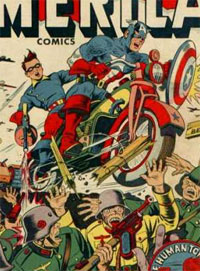 Somewhat at odds with the title's socio-political themes was the character's use of a gun. During the Golden Age, comic characters using guns was widely accepted with everyone from the Bucky to Batman driving dirty. However in the Silver Age, as the villains were no longer soulless soldiers of Axis, guns disappeared in comics. (This was also most likely a result of the sanitizing of comics that came with the introduction of the comic’s code.)
Somewhat at odds with the title's socio-political themes was the character's use of a gun. During the Golden Age, comic characters using guns was widely accepted with everyone from the Bucky to Batman driving dirty. However in the Silver Age, as the villains were no longer soulless soldiers of Axis, guns disappeared in comics. (This was also most likely a result of the sanitizing of comics that came with the introduction of the comic’s code.)
It wasn't until such movies like Dirty Harry and Death Wish started popularizing the concept of vigilante justice that you began to see the return of non-western gun hawks in the Marvel universe. Still, the idea of Spider-man picking up a gun and shooting Electro most likely would not have gone down very well, so stabbing and shooting ones foes was pretty much reserved to anti-heroes (The Punisher) and heroes removed from our time (Skull The Slayer, Deathlok, Killraven). Even in the 80's the only heroes to use guns were The Paladin and Rom. However, by the time the gun happy 90's rolled around, guns were as much of part of characters outfit as shoulder pads and leather jackets.
I think it starts to become easy to see how the 90's Deathlok might not have been able to compete against the Deathlok of the 70's in the hearts and minds of readers. Much of the character's world, which was integral to the concept, had been dropped. And the few aspects they kept (cybernetics, guns, monstrous appearance) were now so commonplace in comics that poor cutting edge Deathlok was lost amongst a sea of Cable/Punisher rip-offs. (Hey, who remembers Gunfire?)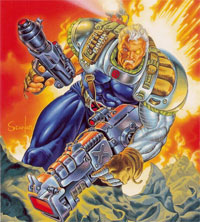 And speaking of Cable, I've heard people say he was inspired by Deathlok, but I think that's just another case of common influences. (Like how the Heap inspired both Man-Thing and Swamp Thing) To me, Cable is Deathlok if you strip away those elements that made Deathlok human. And this is where the McDuffie version of Deathlok was successful over all the Cable Clones, in that McDuffie never forgot the human element of Luther Manning. However, I don't think that was enough to make the character work in the 90's. He was reintroduced in name only during Marvel's weird little M-Tech line of comics in 1998. And a few other versions have been talked about at Marvel since then, but outside of an appearance in the Beyond! mini-series, Deathlok hasn't really been seen since.
And speaking of Cable, I've heard people say he was inspired by Deathlok, but I think that's just another case of common influences. (Like how the Heap inspired both Man-Thing and Swamp Thing) To me, Cable is Deathlok if you strip away those elements that made Deathlok human. And this is where the McDuffie version of Deathlok was successful over all the Cable Clones, in that McDuffie never forgot the human element of Luther Manning. However, I don't think that was enough to make the character work in the 90's. He was reintroduced in name only during Marvel's weird little M-Tech line of comics in 1998. And a few other versions have been talked about at Marvel since then, but outside of an appearance in the Beyond! mini-series, Deathlok hasn't really been seen since.
Still in this era of Corporate Bank instigated economic upheaval, Guantanamo Bay, and revolutionary genetic advancements, I could see someone working with many of the same themes Buckler did and create a new Deathlok. And as long as they remembered to make the character a result of his dark future and not just a part of it, they would most likely succeed.
Have a great weekend!
- Jim

4 comments:
Good column, Jim. Deathlok has always been one of my favorite Bronze Age characters as well...in fact I'm a little miffed you beat me to the punch of writing an article about him. I guess that's editor's perogative ;)
Thank you Trey! I don't know if it's quite as illuminating as your columns have been, but I had fun writing it! :)
Excellent piece, Jim! I'd second everything you say here. I didn't see much of McDuffie's revamp; I remember hearing about it and thinking this was clearly one of those cases where a character was so idiosyncratic he ought to be considered off-limits to anyone but the original creators -- as much to preserve the long-term value of the character as to show respect for those creators. But of course, Marvel never went in for that sort of thing, did they? At the very least, Deathlok never belonged in the MU. That was just weird.
One point: I don't know if it's covered in the Back Issue interview (I'm missing that particular issue; now I'll have to get it!) but there was much more to Luther Manning's backstory Buckler never had a chance to disclose -- one thing in particular would have changed the context of a lot that we did see. Ah well...
(And another thing, only because I'll probably never have another opportunity to mention this, is that after doing a Don McGregor parody in Howard the Duck #2 with "Killmallard," Steve Gerber briefly considered following it up with a parody of this character to be called either "Ducklok" or "Deathquak"...)
@RAB - Thank you! Killmallard - Man, that brings back memories! (All good!) Never knew that about the Luther Manning backstory - where did you see that?
Post a Comment